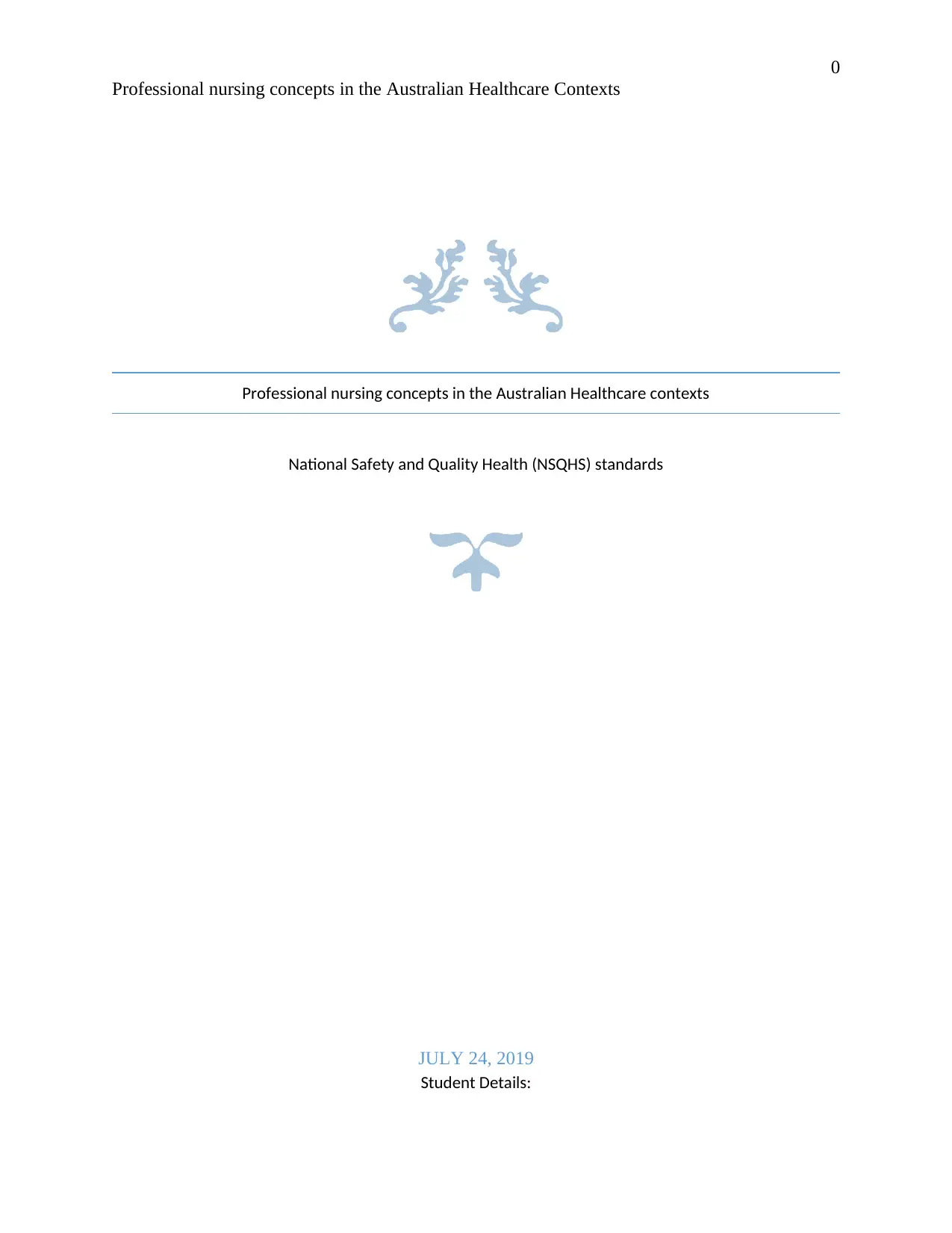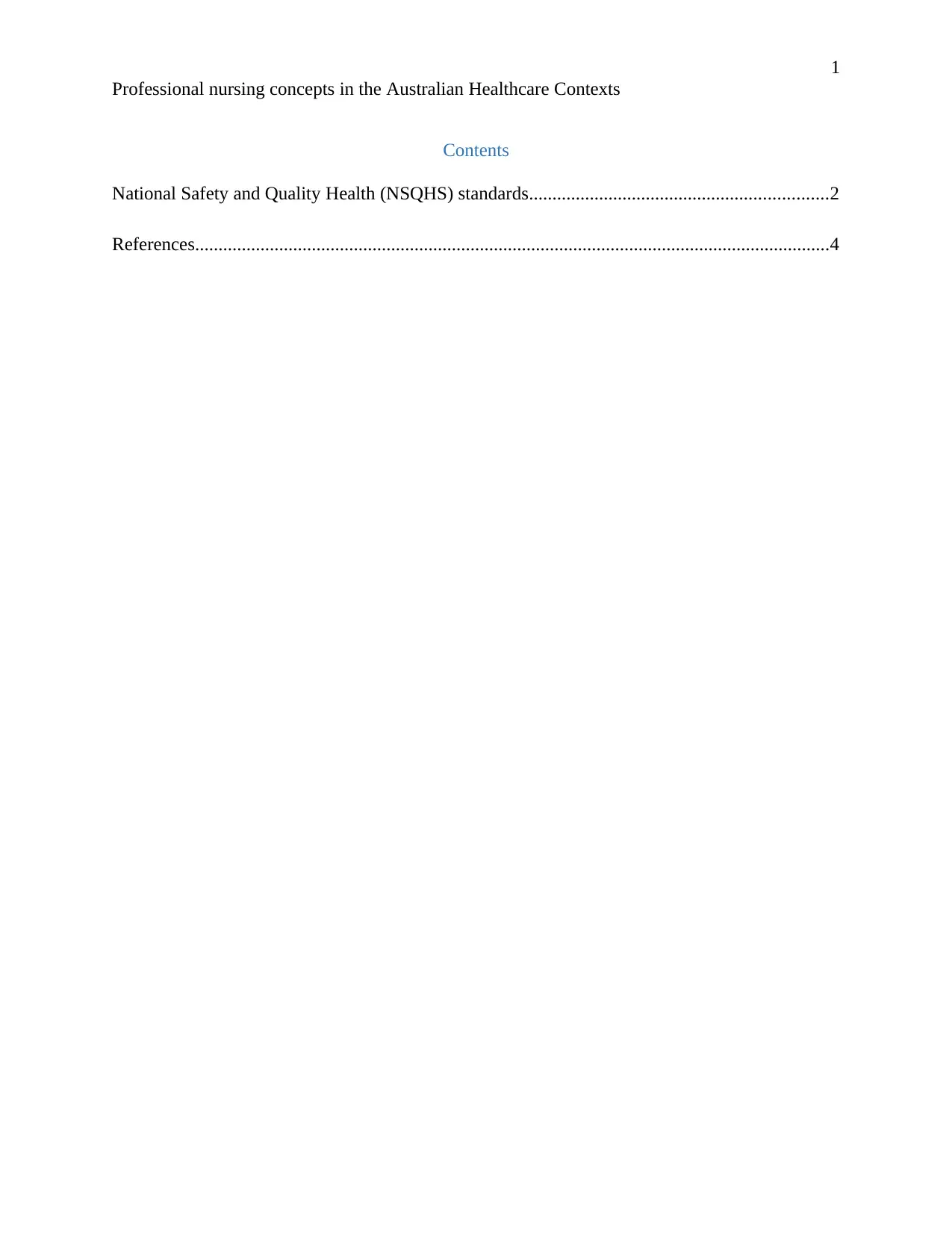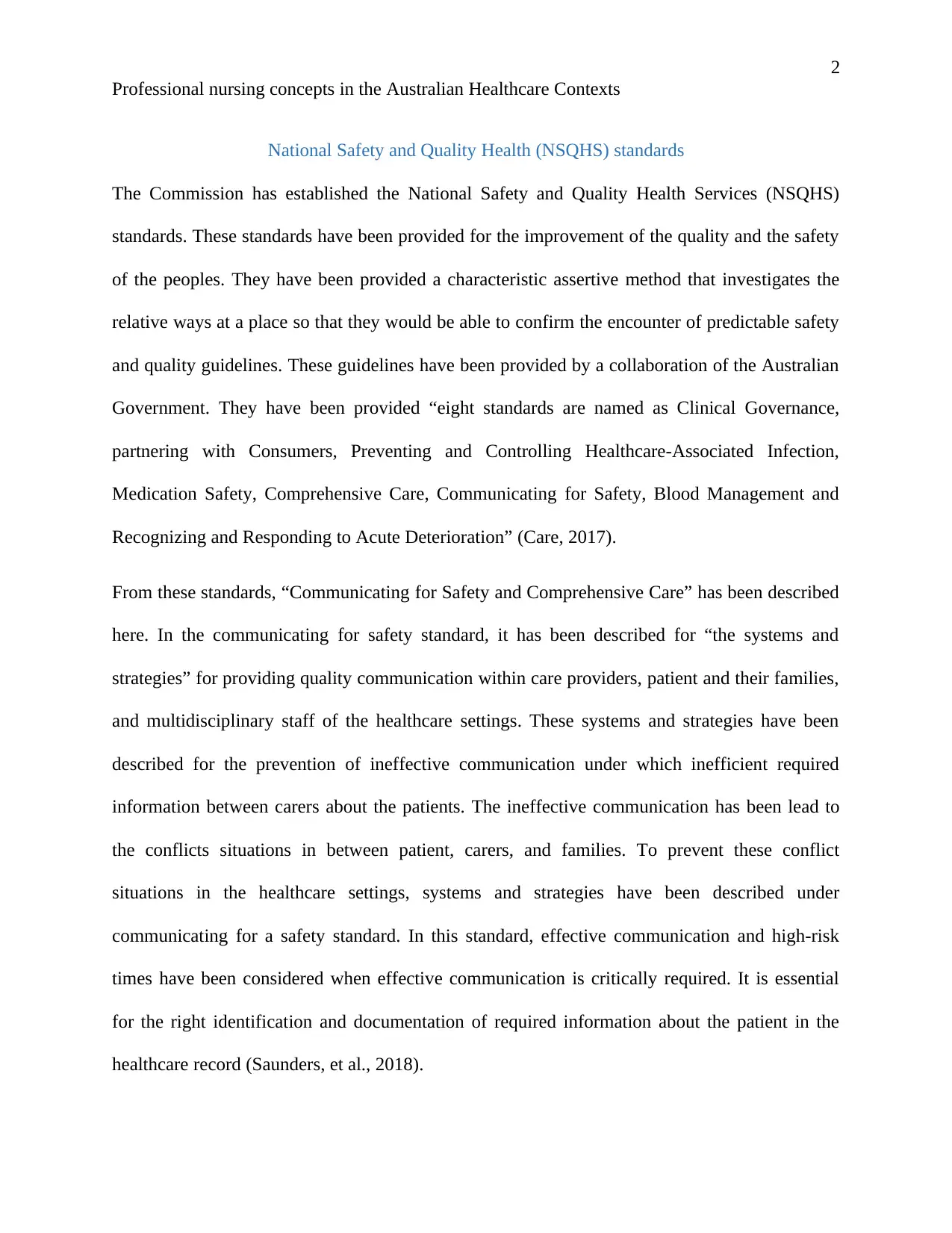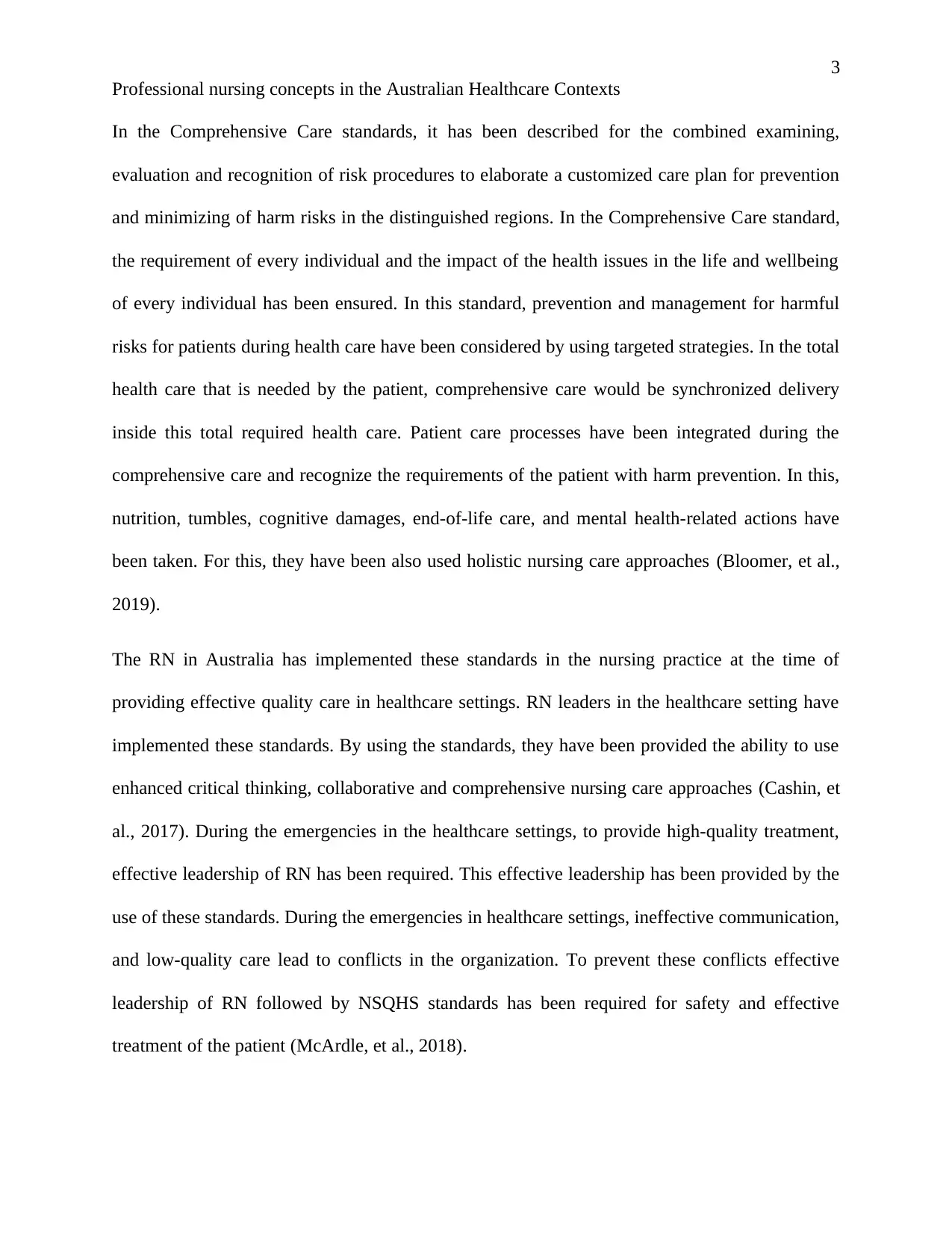National Safety and Quality Health Standards in Australian Nursing
VerifiedAdded on 2022/10/17
|5
|868
|11
Report
AI Summary
This report delves into professional nursing concepts within the Australian healthcare context, specifically focusing on the National Safety and Quality Health Service (NSQHS) standards. It examines two key standards: 'Communicating for Safety' and 'Comprehensive Care,' detailing their importance in ensuring effective communication among healthcare providers, patients, and families, as well as promoting patient safety and preventing harm. The report highlights the role of Registered Nurses (RNs) in implementing these standards, emphasizing the need for enhanced critical thinking, collaborative approaches, and effective leadership, especially during emergencies. It references several studies and guidelines to support the significance of these standards in delivering high-quality patient care and mitigating potential conflicts within healthcare settings.

0
Professional nursing concepts in the Australian Healthcare Contexts
Professional nursing concepts in the Australian Healthcare contexts
National Safety and Quality Health (NSQHS) standards
JULY 24, 2019
Student Details:
Professional nursing concepts in the Australian Healthcare Contexts
Professional nursing concepts in the Australian Healthcare contexts
National Safety and Quality Health (NSQHS) standards
JULY 24, 2019
Student Details:
Paraphrase This Document
Need a fresh take? Get an instant paraphrase of this document with our AI Paraphraser

1
Professional nursing concepts in the Australian Healthcare Contexts
Contents
National Safety and Quality Health (NSQHS) standards................................................................2
References........................................................................................................................................4
Professional nursing concepts in the Australian Healthcare Contexts
Contents
National Safety and Quality Health (NSQHS) standards................................................................2
References........................................................................................................................................4

2
Professional nursing concepts in the Australian Healthcare Contexts
National Safety and Quality Health (NSQHS) standards
The Commission has established the National Safety and Quality Health Services (NSQHS)
standards. These standards have been provided for the improvement of the quality and the safety
of the peoples. They have been provided a characteristic assertive method that investigates the
relative ways at a place so that they would be able to confirm the encounter of predictable safety
and quality guidelines. These guidelines have been provided by a collaboration of the Australian
Government. They have been provided “eight standards are named as Clinical Governance,
partnering with Consumers, Preventing and Controlling Healthcare-Associated Infection,
Medication Safety, Comprehensive Care, Communicating for Safety, Blood Management and
Recognizing and Responding to Acute Deterioration” (Care, 2017).
From these standards, “Communicating for Safety and Comprehensive Care” has been described
here. In the communicating for safety standard, it has been described for “the systems and
strategies” for providing quality communication within care providers, patient and their families,
and multidisciplinary staff of the healthcare settings. These systems and strategies have been
described for the prevention of ineffective communication under which inefficient required
information between carers about the patients. The ineffective communication has been lead to
the conflicts situations in between patient, carers, and families. To prevent these conflict
situations in the healthcare settings, systems and strategies have been described under
communicating for a safety standard. In this standard, effective communication and high-risk
times have been considered when effective communication is critically required. It is essential
for the right identification and documentation of required information about the patient in the
healthcare record (Saunders, et al., 2018).
Professional nursing concepts in the Australian Healthcare Contexts
National Safety and Quality Health (NSQHS) standards
The Commission has established the National Safety and Quality Health Services (NSQHS)
standards. These standards have been provided for the improvement of the quality and the safety
of the peoples. They have been provided a characteristic assertive method that investigates the
relative ways at a place so that they would be able to confirm the encounter of predictable safety
and quality guidelines. These guidelines have been provided by a collaboration of the Australian
Government. They have been provided “eight standards are named as Clinical Governance,
partnering with Consumers, Preventing and Controlling Healthcare-Associated Infection,
Medication Safety, Comprehensive Care, Communicating for Safety, Blood Management and
Recognizing and Responding to Acute Deterioration” (Care, 2017).
From these standards, “Communicating for Safety and Comprehensive Care” has been described
here. In the communicating for safety standard, it has been described for “the systems and
strategies” for providing quality communication within care providers, patient and their families,
and multidisciplinary staff of the healthcare settings. These systems and strategies have been
described for the prevention of ineffective communication under which inefficient required
information between carers about the patients. The ineffective communication has been lead to
the conflicts situations in between patient, carers, and families. To prevent these conflict
situations in the healthcare settings, systems and strategies have been described under
communicating for a safety standard. In this standard, effective communication and high-risk
times have been considered when effective communication is critically required. It is essential
for the right identification and documentation of required information about the patient in the
healthcare record (Saunders, et al., 2018).
⊘ This is a preview!⊘
Do you want full access?
Subscribe today to unlock all pages.

Trusted by 1+ million students worldwide

3
Professional nursing concepts in the Australian Healthcare Contexts
In the Comprehensive Care standards, it has been described for the combined examining,
evaluation and recognition of risk procedures to elaborate a customized care plan for prevention
and minimizing of harm risks in the distinguished regions. In the Comprehensive Care standard,
the requirement of every individual and the impact of the health issues in the life and wellbeing
of every individual has been ensured. In this standard, prevention and management for harmful
risks for patients during health care have been considered by using targeted strategies. In the total
health care that is needed by the patient, comprehensive care would be synchronized delivery
inside this total required health care. Patient care processes have been integrated during the
comprehensive care and recognize the requirements of the patient with harm prevention. In this,
nutrition, tumbles, cognitive damages, end-of-life care, and mental health-related actions have
been taken. For this, they have been also used holistic nursing care approaches (Bloomer, et al.,
2019).
The RN in Australia has implemented these standards in the nursing practice at the time of
providing effective quality care in healthcare settings. RN leaders in the healthcare setting have
implemented these standards. By using the standards, they have been provided the ability to use
enhanced critical thinking, collaborative and comprehensive nursing care approaches (Cashin, et
al., 2017). During the emergencies in the healthcare settings, to provide high-quality treatment,
effective leadership of RN has been required. This effective leadership has been provided by the
use of these standards. During the emergencies in healthcare settings, ineffective communication,
and low-quality care lead to conflicts in the organization. To prevent these conflicts effective
leadership of RN followed by NSQHS standards has been required for safety and effective
treatment of the patient (McArdle, et al., 2018).
Professional nursing concepts in the Australian Healthcare Contexts
In the Comprehensive Care standards, it has been described for the combined examining,
evaluation and recognition of risk procedures to elaborate a customized care plan for prevention
and minimizing of harm risks in the distinguished regions. In the Comprehensive Care standard,
the requirement of every individual and the impact of the health issues in the life and wellbeing
of every individual has been ensured. In this standard, prevention and management for harmful
risks for patients during health care have been considered by using targeted strategies. In the total
health care that is needed by the patient, comprehensive care would be synchronized delivery
inside this total required health care. Patient care processes have been integrated during the
comprehensive care and recognize the requirements of the patient with harm prevention. In this,
nutrition, tumbles, cognitive damages, end-of-life care, and mental health-related actions have
been taken. For this, they have been also used holistic nursing care approaches (Bloomer, et al.,
2019).
The RN in Australia has implemented these standards in the nursing practice at the time of
providing effective quality care in healthcare settings. RN leaders in the healthcare setting have
implemented these standards. By using the standards, they have been provided the ability to use
enhanced critical thinking, collaborative and comprehensive nursing care approaches (Cashin, et
al., 2017). During the emergencies in the healthcare settings, to provide high-quality treatment,
effective leadership of RN has been required. This effective leadership has been provided by the
use of these standards. During the emergencies in healthcare settings, ineffective communication,
and low-quality care lead to conflicts in the organization. To prevent these conflicts effective
leadership of RN followed by NSQHS standards has been required for safety and effective
treatment of the patient (McArdle, et al., 2018).
Paraphrase This Document
Need a fresh take? Get an instant paraphrase of this document with our AI Paraphraser

4
Professional nursing concepts in the Australian Healthcare Contexts
References
Bloomer, M. J., Hutchinson, A. M. & Botti, M., 2019. End-of-life care in hospital: an audit of
care against Australian national guidelines. Australian Health Review.
Care, A. C. o. S. a. Q. i. H., 2017. National Safety and Quality Health Service Standards. 2nd ed.
Sydney: ACSQHC.
Cashin, A. et al., 2017. Standards for practice for registered nurses in Australia. Collegian, 24(3),
pp. 255-266.
McArdle, J. et al., 2018. Strategies to Improve Management of Shoulder Dystocia Under the
AHRQ Safety Program for Perinatal Care. Journal of Obstetric, Gynecologic & Neonatal
Nursing, 47(2), pp. 191-201.
Saunders, R. et al., 2018. Graduate registered nurses’ reflections on implementing safety and
quality improvement projects. Reflective Practice, 10(5), pp. 678-689.
Professional nursing concepts in the Australian Healthcare Contexts
References
Bloomer, M. J., Hutchinson, A. M. & Botti, M., 2019. End-of-life care in hospital: an audit of
care against Australian national guidelines. Australian Health Review.
Care, A. C. o. S. a. Q. i. H., 2017. National Safety and Quality Health Service Standards. 2nd ed.
Sydney: ACSQHC.
Cashin, A. et al., 2017. Standards for practice for registered nurses in Australia. Collegian, 24(3),
pp. 255-266.
McArdle, J. et al., 2018. Strategies to Improve Management of Shoulder Dystocia Under the
AHRQ Safety Program for Perinatal Care. Journal of Obstetric, Gynecologic & Neonatal
Nursing, 47(2), pp. 191-201.
Saunders, R. et al., 2018. Graduate registered nurses’ reflections on implementing safety and
quality improvement projects. Reflective Practice, 10(5), pp. 678-689.
1 out of 5
Related Documents
Your All-in-One AI-Powered Toolkit for Academic Success.
+13062052269
info@desklib.com
Available 24*7 on WhatsApp / Email
![[object Object]](/_next/static/media/star-bottom.7253800d.svg)
Unlock your academic potential
Copyright © 2020–2025 A2Z Services. All Rights Reserved. Developed and managed by ZUCOL.





